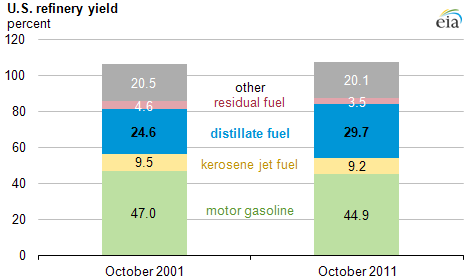
Posted on 01/18/2012 6:52:43 AM PST by thackney
In October 2011, the refinery yield of distillate fuels (a category that includes diesel fuel and heating oil) reached 29.7%, matching the previous record set in December 2008. For all major products, only the distillate yield is higher now than it was in October 2001.
Since 2001, distillate yields have followed an upward trend, peaking in December 2008 before falling back to an average of 27.5% in 2010. During 2011, the distillate yield grew, reaching 29.7% in October (latest EIA data available). The recent uptick in distillate yield can partly be explained by the significantly higher price margins over the cost of crude oil for distillate relative to gasoline. It can also be explained by growing distillate exports, which reached a record of 1,067 thousand barrels per day in October 2011. Refineries in the U.S. still average about 1.5 times as much gasoline as distillate from each barrel of oil refined, up from about 2 times from the 1990s to 2004. In response to market conditions, refiners took steps to maximize distillate yield and production.
Refiners can adjust product yields in response to changing product prices and other market conditions by varying refinery processes and the types of crude oil they choose to refine. For most products, refinery yields are calculated as barrels of finished product produced divided by the sum of crude oil and unfinished oils inputs. However, calculating gasoline yields is slightly more complicated. When calculating yields for motor gasoline, U.S. total finished gasoline production must be adjusted for imported blending components, ethanol, and some "other inputs" including natural gas plant liquids, hydrogen, and other hydrocarbons.
The yields sum to more than 100% due to processing gain, which is the volumetric amount by which total output is greater than input for a given period of time. Refinery processing gain results from some refining processes, such as fluid catalytic cracking and hydrocracking, where volumes can increase when large, heavy molecules are broken into smaller and lighter molecules that take up more space.
The refinery processing gain has also grown over the last decade. It reached 7.3% in October 2011. Processing gains tend to increase as refineries add cracking capacity and as the product slate changes from heavier products (like residual fuel oil) to lighter ones (like motor gasoline and distillate fuel).

People used to sneak in and steal it by the 55 gallon drum. Had to be careful because you would start your vehicle but couldnt get it to turn off!
Good news about distillates. However, it’d be nice if the damned EPA would certify more diesel-powered passenger vehicles - basically, you either buy a VW product, or you have to pay tons of money for a BMW or Mercedes or similar vehicles. I’d LOVE to see a diesel hybrid - it’d blow the Prius out of the water, getting 20% better mileage. It bothers me a lot that our freedom of choice is severely hampered, while we manufacture diesel vehicles by the shipload for export to Europe.
“Refineries in the U.S. still average about 1.5 times as much gasoline as distillate from each barrel of oil refined, up from about 2 times from the 1990s to 2004.”
What?
Does anybody think about what they write anymore? Are these journalism majors because they certainly are not math mavens.
Notice how much is being shipped OUT of the country. We can’t use the high sulfur being shipped out. Just the low sulfur junk that destroys diesel engines.
They were talking about the distillates, not the gasoline.
Disclaimer: Opinions posted on Free Republic are those of the individual posters and do not necessarily represent the opinion of Free Republic or its management. All materials posted herein are protected by copyright law and the exemption for fair use of copyrighted works.